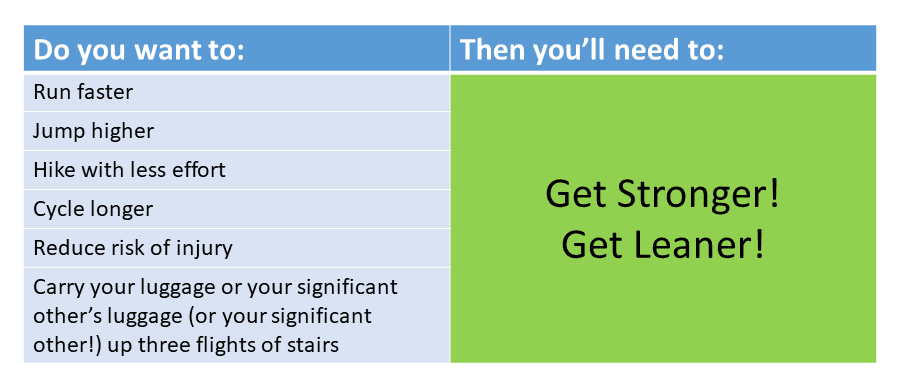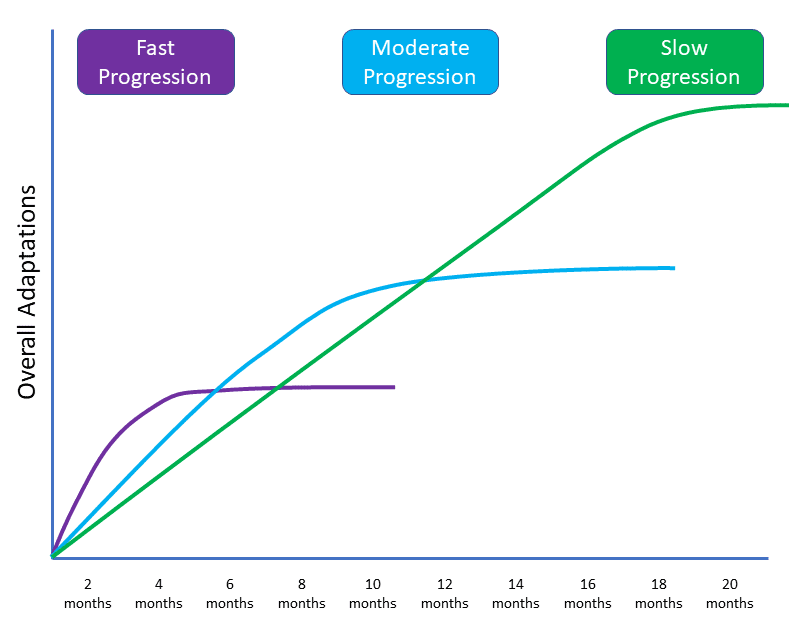Overweight and Unfit Workout Guide: Tips, Exercises & Simple Plans for Beginners

Working out is hard, especially when you’re overweight and unfit.
Even simple things like walking up stairs can be tough. Running? Forget it. The gym? It’s intimidating. Maybe you tried working out before and thought “Man, I can’t do this.” The discomfort and pain can be really tough.
But there’s a way. In this guide, I’ll give you simple workouts for overweight beginners. I’ll also tell you what to focus on based on my years of experience coaching clients and getting a PhD in exercise physiology.
Hint: most people get it wrong.
Overweight and Unfit: Where do I start?
Get stronger, get leaner! Here’s why:
Table 1—Benefits of getting stronger and leaner

Of course, you’ll look better and build muscle. But beyond aesthetics, the most noticeable benefits you can get from exercising come from improving your power to mass ratio. Think strength-speed.
Power/Mass ≈ Physical Performance
And from beginners to intermediates, the most efficient way to improve the power to mass ratio is by getting stronger and leaner.
Anytime we move, we need to produce enough power to overcome our body mass. The lower our body mass and the more power we can produce, the easier tasks of daily living, recreation, and athletics become.
There are also many more benefits to getting fit and losing weight. For one, you’ll improve your health (even before you lose any weight). Indeed, studies show that overweight but physically active individuals are healthier than normal weight, but sedentary ones.
2 factors overweight beginners need to consider
If you’re overweight and unfit, there are 2 factors you should consider when adopting an exercise plan: your rate of adaptation and the complexity of your training. Understanding how these factors influence fitness and weight loss will allow you to set goals, manage expectations, and design a safe and effective workout program.
Avoid improvement plateaus
Figure 1 illustrates the concept of accommodation and stagnation (aka: plateaus) with varying rates of progressive overload (how fast you increase the intensity and volume of training). Aggressively increasing the overload will result in faster results, but a plateau in training will occur sooner and at a lower level of overall improvement. Instead, slow and steady increases in overload will delay the plateau and result in a greater level of fitness achieved.
Figure 1—Progression rate and plateau relationships

Complexity increases with experience
In figure 2, observe the rate of adaptation. When one first begins training the rate of adaptation is very high, but as one’s fitness increases, the improvements slow. You’ll also note that little volume and complexity is necessary to see improvements when one starts training, but as fitness rises and the rate of adaptation slows, more volume and complexity is necessary to continue improving. So, as you get more advanced, you’ll need more complex programs. We have a guide for that: Muscle Hypertrophy: How to Progress your Training for Size.
Figure 2—The relationship between fitness level, rate of improvement, and training needs

What have we learned?
- Beginners can make large improvements in fitness.
- Beginners require less volume and complexity improve.
- Slowly adding to your workouts leads to more consistent improvements.
- There is no need to rush, slower improvements are more sustainable.
How should an overweight person start exercising?
A balanced workout program for an overweight and unfit beginner will address the 5 components of fitness either directly or indirectly: cardiovascular fitness, muscular strength, muscular endurance, flexibility, and body composition.
Remember, complexity for a beginner does not need to be high. A program that focuses on muscular strength and cardiovascular fitness, in addition to proper nutrition, will result in improvements in muscular endurance, flexibility and body composition (i.e.: body fat percentage, how your clothes fit and how you look in the mirror) as well.
As you get stronger and your endurance improves, you will notice positive changes in body composition and daily/recreational activities.
What goals should I set?
With that in mind, the goals you set should be related to muscular strength and cardiovascular fitness, and the exercises you employ should be tailored to meet those goals. Of course, you can also train for muscle hypertrophy. See our Definitive Guide to Muscle Hypertrophy Workouts for Beginners for that.
For overweight beginners looking to improve their cardio, the 6-minute walk test is a simple way to monitor your progress. Fit adults under the age of 50 can walk about 600-700 meters in 6 minutes. Aim to increase your 6-minute walk test by approximately 30-50 m per month for the first 4-6 months.
Measuring muscular strength can be done by keeping records of your resistance training workouts. Aim for increases in the weights you’re using in the gym by about 4-8% per month for the first 4-6 months.
Simple workout for overweight beginners
Now that we’ve established beginners should do a combination of strength and cardiovascular training, start easy and simple, and progress slowly, let’s set a few strength training guidelines and then look at some examples.
Table 2—Programming guidelines for overweight beginners
| Guideline | Description |
|---|---|
| Exercise frequency | Train each major movement once to twice per week |
| Exercise selection | 6-8 exercises per session
Perform heaviest/hardest exercises first in session |
| Major movements Lower body |
Squat: squat, leg press, hack squat
Hinge: deadlift variations, good morning, back extension Split stance: lunge, step ups, split squats |
| Major movements Upper body |
Transverse push: bench press, incline press, chest fly
Vertical push: Shoulder press, military press Transverse pull: Seated row, inverted row, bar/dumbbell row Vertical pull: pull up, lat pull down |
| Exercise intensity | Select a weight that will allow you to complete the required repetitions with an estimated 3-4 repetitions in reserve for first 1-2 workouts
Increase the load 1-2% every 1-2 weeks |
| Volume | 2-3 sets for major movements, 1-2 sets for minor movements for first 2-4 weeks
10-15 repetitions per set for first 8-12 weeks |
| Rest | 45 seconds to 2 minutes between sets, with more rest for heavier movements
Strength training should be challenging (elevated heart rate and breathing) but it’s important your strength recovers between sets for maximal effects |
Try Dr. Muscle For Free To Lose Weight And Become Fit
Easy workout for overweight beginners
What follows are two full body workouts to be done two days a week on non-consecutive days. To increase time efficiency, exercises in the same boxes are super sets. After 8-12 weeks, change some of the exercises and repeat with a higher starting volume and intensity.
Beginner gym workout for an overweight male
Table 3—Beginner gym workout for an overweight male
| Day 1 | Day 2 |
|---|---|
| Leg Press | Goblet or Front Squat |
| Stiff Leg Dead Lift | Step Ups |
| Barbell Bench Press | Machine Shoulder Press |
| Dumbbell Row | Lat Pull Down |
| Dumbbell Curls Triceps Press Down |
Chest Fly Rev. Dumbbell Raise |
| Dead Bug Exercise Russian Twists |
Front Plank Side Plank |
Table 4—Example beginner progressions
| Week | Volume | Effort (reps shy of failure) | Cardio (min x % HRmax) |
|---|---|---|---|
| 1 | 2 x 15 | 4 | 15 x 60% |
| 2 | 2 x 15 | 3 | 18 x 60% |
| 3 | 3 x 15 | 2 | 20 x 62.5% |
| 4 | 3 x 15 | 2 | 22 x 62.5% |
| 5 | 2 x 10 | 3 | 20 x 65% |
| 6 | 3 x 10 | 2 | 20 x 65% |
| 7 | 3 x 10 | 2 | 22 x 65% |
| 8 | 3 x 10 | 1-2 | 25 x 65% |
- Heart Rate Maximum = 220 – age
- Perform cardio twice weekly, either following strength training or on non-strength training days
- Unsupported cardio (walking, jogging, stair climbing) will burn more calories compared to supported cardio (elliptical, cycling).
- When using a treadmill, adjust the incline to increase the intensity to reach desired & HRmax
While the above workout is quite versatile and effective, it can be modified for females. Women tend to have a greater percentage of lower body muscle mass and a general desire to develop those muscles more so than men.
Beginner workout for an overweight female
Table 5—Beginner workout for an overweight female
| Day 1 | Day 2 |
|---|---|
| Leg Press | Goblet or Front Squat |
| Stiff Leg Dead Lift | Step Ups |
| Barbell Bench Press | Machine Shoulder Press |
| Dumbbell Row | Lat Pull Down |
| Hip Thrusts Hip Abduction Machine |
Leg Extensions Leg Curls |
| Dead Bug Exercise Russian Twists |
Front Plank Side Plank |
Advanced Beginner Workout
If you’ve followed the above strength training workout for 8 weeks, or you responded really well and feel you can handle more, then here is a progression/advancement.
A more advanced workout routine for overweight beginners
Table 6—A more advanced workout routine for overweight beginners
| Day 1 | Day 2 | Day 3 | Day 4 |
|---|---|---|---|
| Back Squat | Bench Press | Trap Bar Deadlift | Barbell Shoulder Press |
| Split Squat | Bent Over Row | 1 Leg Leg Press | Pull Ups |
| Romanian Deadlifts | DB Shoulder Press Underhand Pulldown |
Leg Extensions Leg Curls |
DB Incline Press Seated Row |
| Hip Thrusts Hip Abduction |
Lateral Delt. Raise Barbell Shrug |
Ab Roll Outs Palloff Holds |
Skull Crusher DB Curls |
Table 7—Example intermediate progressions
| Week | Volume | Effort (reps shy of failure) |
|---|---|---|
| 1 | 3 x 12 | 3 |
| 2 | 3 x 12 | 2 |
| 3 | 3 x 12 | 1 |
| 4 | 4 x 12 | 0-1 |
| 5 | 3 x 10 | 2 |
| 6 | 3 x 10 | 2 |
| 7 | 4 x 10 | 1 |
| 8 | 4 x 10 | 0-1 |
Get in shape faster with a trainer in your phone
You can follow the workouts above (and many more) inside Dr. Muscle, our smart workout app. It’s like a trainer in your phone. It automates your training, and guides you like an expensive coach (just without the expensive fees).
Try Dr. Muscle For Free To Lose Weight And Become Fit
